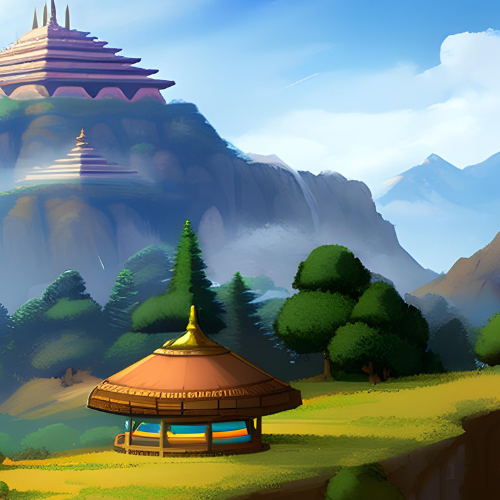The Chola Dynasty was one of the longest-ruling and most powerful dynasties in the history of South India. It emerged in the Tamil region during the 9th century CE and reached its peak of prosperity and influence during the 10th to 12th centuries CE. The Chola rulers established a strong centralized government, implemented efficient administrative systems, and were known for their military prowess, naval expeditions, patronage of the arts, and architectural achievements.
Under the Chola Dynasty, a series of capable and ambitious kings ascended to the throne, expanding their empire through conquests and diplomacy. The most notable among them were Rajaraja Chola I (reigned 985-1014 CE) and his son Rajendra Chola I (reigned 1014-1044 CE). Rajaraja Chola I initiated the construction of the grand Brihadeeswarar Temple in Thanjavur, a UNESCO World Heritage site and a masterpiece of Dravidian architecture.
The Cholas were skilled naval navigators and controlled a significant portion of trade in the Indian Ocean. They established a strong navy and conducted successful naval expeditions to various regions, including Sri Lanka, the Maldives, Southeast Asia, and even parts of East Africa. This maritime dominance contributed to their economic prosperity and cultural exchanges with other regions.
The Chola Dynasty also played a vital role in the development of art, literature, and religious practices in South India. They were great patrons of the arts and encouraged the growth of Tamil literature, sculpture, painting, and music. The courts of Chola kings attracted talented poets, scholars, and artists, contributing to a flourishing cultural environment.
In addition to their achievements in governance, military conquests, and cultural patronage, the Chola Dynasty left behind an enduring legacy of architectural marvels. The Chola temples, with their intricate carvings, towering gateways, and elaborate sculptures, are considered some of the finest examples of South Indian temple architecture.
The decline of the Chola Dynasty began in the 13th century CE, with a series of invasions by other regional powers and internal conflicts. The dynasty gradually lost control over its territories, and by the 14th century, the Pandya and Vijayanagara kingdoms emerged as dominant powers in South India, effectively ending the Chola reign.
Despite their eventual decline, the Chola Dynasty is remembered as a golden age in the history of South India, known for its administrative efficiency, cultural contributions, and architectural marvels that continue to awe people even today.
Administration and Governance: The Chola Dynasty implemented a well-organized administrative system that comprised multiple levels of governance. The empire was divided into administrative units called Mandalams, which were further divided into autonomous villages. The king appointed officials to oversee revenue collection, justice administration, and the overall governance of each region. Local self-government was also encouraged, allowing local communities to manage their own affairs to some extent.
Economic Prosperity: The Chola Dynasty’s economic strength was built on agriculture, trade, and maritime activities. The region’s fertile lands facilitated prosperous agriculture, with the cultivation of crops such as rice, sugarcane, and cotton. Trade flourished through a network of ports, and the Cholas established trade links with distant regions, including Southeast Asia, China, and the Arabian Peninsula. The Chola Empire was known for its valuable exports, such as spices, silk, textiles, precious gems, and metalwork.
Social Structure: The Chola society was organized into hierarchical social classes. At the top were the kings and the ruling elite, followed by the nobility, landowners, and merchants. The majority of the population consisted of farmers and agricultural laborers. Social mobility was possible, with individuals having the opportunity to rise in status through education, military service, or royal patronage.
Religious Patronage: The Chola Dynasty had a deep connection with Hinduism, and the rulers actively supported and patronized temples and religious institutions. They granted land and resources to temples, leading to the accumulation of significant wealth and the development of temple-based economies. The kings themselves were considered divine and performed religious ceremonies to legitimize their rule. The patronage of temples also fostered the growth of devotional literature and the Bhakti movement, which emphasized personal devotion to a chosen deity.
Literature and Language: The Chola period witnessed a remarkable literary flourishing in the Tamil language. Many notable works were composed during this time, including the epic poem “Silappatikaram” and the philosophical treatise “Tirukkural.” The Cholas established educational institutions known as “gurukulams,” where students received education in literature, grammar, astrology, and other subjects. The royal court attracted renowned poets and scholars, and the kings themselves were known to be patrons of poetry and literature.
Legacy and Influence: The impact of the Chola Dynasty extends beyond its historical era. The architectural and artistic achievements of the Cholas left an indelible mark on South Indian culture and continue to inspire contemporary architects and artists. The administrative systems developed by the Cholas laid the foundation for subsequent South Indian kingdoms. The maritime dominance of the Cholas contributed to the growth of trade and cultural exchanges in the Indian Ocean region.
Overall, the Chola Dynasty’s contributions in the realms of governance, trade, art, literature, and architecture have had a lasting impact on the cultural heritage of South India and continue to be celebrated and admired today.
Q. Why did the Cholas build a strong naval fleet?
Answer – The Cholas recognized the importance of maritime trade and sought to establish and protect their trade networks. They aimed to expand their empire beyond the Indian subcontinent, and a strong navy enabled them to conquer coastal regions and islands. Additionally, the Cholas understood the strategic value of naval power in defending against invasions and conducting naval warfare. Their strong naval fleet also facilitated maritime diplomacy and cultural exchange with other regions. Click for a long answer





